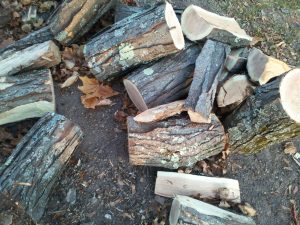Is Walnut Good for Firewood – Burning Characteristics of Walnut
If you have a woodlot or a woodsman that offers walnut firewood, make sure you find out whether or not that’s black or white walnut. White walnut wood is much softer; black walnut wood is often used in furniture-grade production. English walnut trees actually produce the walnuts that we commonly bake with. It is possible to eat black walnuts, but they are extremely messy to husk and many people find the flavor of black walnuts to be unpleasant.

Heat Output and Efficiency (in BTUs)
Black walnut generates just over 22 million BTUs per full cord of wood. Do be aware that black walnut is quite hard and will be hard to split when it’s wet. If you can find black walnut that is firewood grade, it will be smaller diameter than the black walnut that is grown for furniture grade lumber.
Walnut tree bark has very deep fissures. If you take possession of freshly cut walnut, take the time to score within the fissures at just a couple of points on each log and put the logs with the end grain facing the wind to encourage drying.
Splitting these small rounds of walnut may be easier than splitting large rounds of elm or pine. Once they have seasoned for a time, settle a round on your splitting block, step back and try splitting it. If you use a tire to hold your wood, be aware that the small rounds of walnut may not have enough support to hold them sturdy while you split.
Line the inside of your splitting tire setup with three shorter rounds to create a supportive triangle for the round you’re trying to cut. Not only will this set up save you a lot of bending and stooping to pick up your freshly split walnut, but you will avoid burying your ax blade in the dirt if you miss. Finally, a good splitting block setup means that any wood that flies off isn’t hitting you in the feet or legs as it goes.
Creosote Buildup
Properly seasoned, walnut offers a nice hot fire. Your risk of creosote build-up when burning black walnut is very low. The softer white walnut will produce a bit more ash. As your chimney cools after a walnut fire, moisture will cling to the liner and ash will turn to sludge; the next time you get the chimney hot, you may end up with a sticky, tarry product burned to the inside of your chimney.
Walnut trees actually do produce a sap that can be cooked down to sugar. Always get your chimney serviced before the first fire of fall to avoid creosote damage and chimney fires.
Amount of Smoke, Spark and Coal Production
Seasoned walnut, whether white or black, will produce very low smoke and little spark risk. That being said, this wood burns down to ash quickly. If you need a bed of coals at the end of a good fire, don’t burn strictly walnut. Mix it up with elm or oak to get a decent bed of coals for more heat over time.
That being said, the scent of walnut when burning is both pleasant and mild. Because this wood is quite pretty in your fireplace, it can be a lovely fire to use more for display than for heat. If you only have walnut to use in your woodstove and you need the fire to keep your house warm, you can expect to have to get up in the night.
Walnut offers a lovely straight grain and very few knots. This is why it is so prized among furniture makers. You can expect a steady, smooth burn before the wood fades to ash.
How Long Should You Season Walnut Firewood?
Walnut will need to season for at least 6 months. Because it’s pretty tough to cut this wood when it’s freshly harvested, you will want to split it after a few months of seasoning. The rounds will be fairly small and lightweight if they’re urban harvested, so they’re easy to manage even when wet.
Walnut trees love sunshine and walnut wood needs the same. The heavily fissured bark will split fairly easily if this wood is stacked where it can get sun and wind. If you’ve got a rainy season or you know there’s a bout of heavy rains coming, try to tarp your woodpile without blocking airflow.
Though walnut is harder than a lot of firewood options, it still can’t be stored on the ground. Park your walnut firewood on pallets or stringers to avoid losing the first layer to rot when you get down to it.
Is Walnut Firewood Expensive
Black walnut trees secrete a toxin at the roots. While shallow rooted plants will grow under black walnut trees, deeper rooted plants will not do well under black walnut trees. Curiously, this makes black walnut tree groves look like old growth forest.
However, black walnut trees that are chosen for firewood harvest are often urban harvested. If a landowner is planning to grow walnut for fine lumber harvest, they may hire a woodsman to then out crowded walnut trees. If you can find a wood lot that includes skinny, over-crowded black walnut trees, you may get a good price on walnut firewood. Just be aware that once the crowded trees are removed, you may not be able to get walnut firewood from this landowner.]
If you own a woodlot that is loaded with overcrowded walnut trees, harvest in the spring. Black walnut trees in particular are difficult to work under in the fall; the ground is covered with walnuts that are filthy to handle and dangerous to walk on. If the local squirrels have located your black walnut trees, they will help you grow many more of them and will clean out the dropped walnuts that can make walking treacherous.
Finally, cleaning up walnut trees in the spring can actually be a great training ground for a young woodsman. The trees are not terribly big in diameter and you can practice felling trees in the right direction. When the walnuts are gone, the ground will actually be easy to cross as there are no understory plants. There is also little risk that a young walnut tree will “barber-chair” or split on you vertically as you cut it. The uncured grain of walnut trees is too fibrous and tough to cause this dangerous problem.
Pros and Cons of Using Walnut for Firewood
Pros
- Walnut wood smells pleasant when burned
- You can season walnut wood for just six months and get a great burn
- After a bit of seasoning, walnut splits easily
Cons
- If you have black walnut trees in your woodlot, they will not allow understory plants
- The walnuts off of black walnut trees are messy to handle
- Any walnut firewood you can find will be small rounds only
How Walnut Firewood Compares to Other Trees
Walnut is a well-known furniture grade hardwood. If you really want to burn walnut and only walnut, you may struggle to find a supplier and the wood will be costly. If you are a woodlot owner, be aware that walnut trees can be a bit sensitive to shade and moisture.


